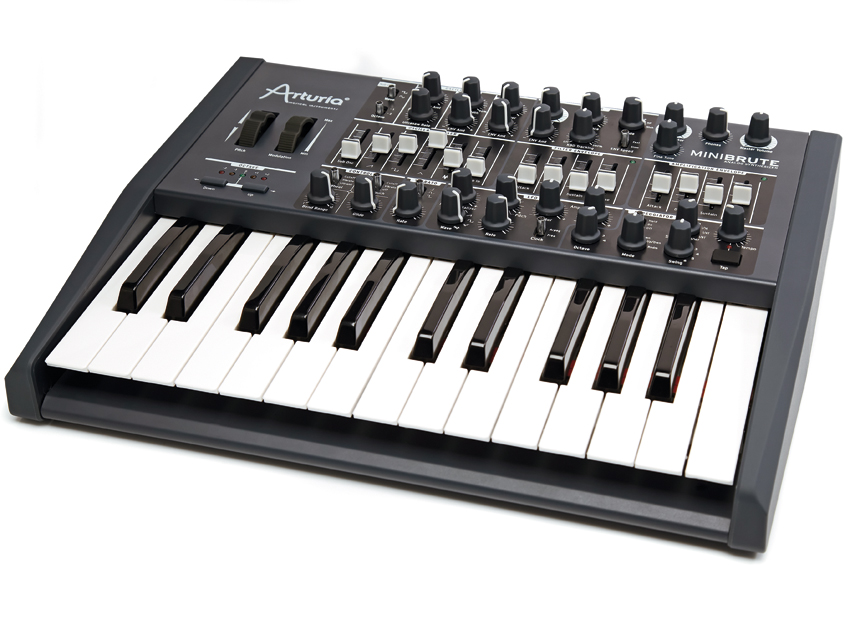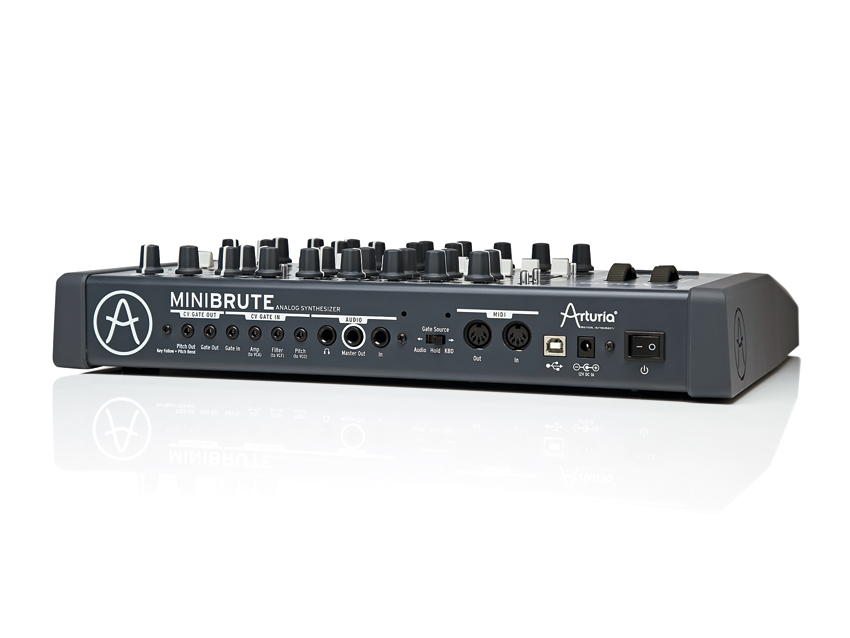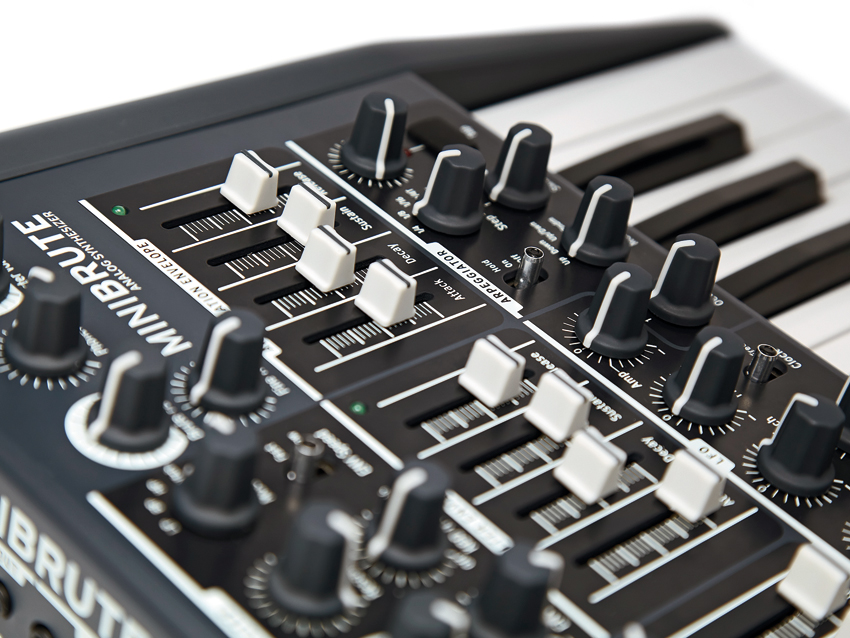MusicRadar Verdict
A great little synth, which manages to pack a lot of punch into its modest frame.
Pros
- +
Fun, adaptable and good in performance; adaptable oscillator wave-shaping options ; unconventional but versatile filter design; flexible arpeggiator section.
Cons
- -
Might be too old-school for some.
MusicRadar's got your back

Arturia MiniBrute

Arturia MiniBrute

Arturia MiniBrute
Arturia needs no introduction in music-tech circles: it's firmly established itself as one of the leading vintage synthesizer emulation development companies, with a range that embraces classic monophonic, modular, polyphonic and digital-analogue hybrid designs.
More recently, it has explored the hardware arena with the standalone DSP-based Origin hardware, or via software and controller systems such as the Spark drum machine.
"In use, the MiniBrute was immense fun and surprisingly flexible. Basses, leads and effects were all easy to achieve, and with no memory storage in sight, experimentation was the key."
Given that all its prior sound-generation systems have been firmly bedded in software, though, it came as quite a surprise when Arturia announced the MiniBrute, a 'real' hardware synth. In essence, it's a single oscillator VCO-based synthesizer allied to a 25-note keyboard - though, as we'll see, this somewhat undersells the full spec.
On opening the box and picking up the unit, the first impression is that the MiniBrute is weighty and substantial. The case is made of aluminium with plastic side-trim, and the keyboard is of the two-octave full-size variety taking up the full width of the unit, above which sit the pitch and modulation wheels, and the densely populated synth programming section - Arturia really does squeeze in a lot of knobs, switches and sliders here.
Disappointingly, the MiniBrute draws its power from an external 12V PSU, though we suspect this won't be a deal-breaker for most.
Ultra metal
The MiniBrute, as stated earlier, has a single oscillator, but this does somewhat understate its sophistication. Before diving-in, it's perhaps worth reminding ourselves of some synth-design parlance.
Although the MiniBrute can generate multiple waveforms simultaneously, they cannot be detuned independently, making this a single oscillator design. The MiniBrute has a VCO (Voltage Controlled Oscillator) and these generally exhibit more obvious analogue traits (especially instability and unpredictability in frequency terms) in comparison to DCO (Digitally Controlled Oscillators) and true digitally-generated designs.
Want all the hottest music and gear news, reviews, deals, features and more, direct to your inbox? Sign up here.
However, there are many variants even within the VCO stable - from discrete designs (built from separate components) to those built into a single custom chip alongside filters, LFOs and envelope control sections.
The MiniBrute falls into the traditional discrete VCO design camp, but includes some interesting additions that take its sound-generating capabilities beyond what, at first glance, appears to be a modern take on Roland's classic SH-101. This also means that the synth requires a warm-up period of at least five minutes to reach a pitch-stable state.
In the mix
The Oscillator mixer section, consisting of six sliders, provides the best overview of what's on offer. Sawtooth, square and triangle waves, alongside a white noise source, can be mixed in varying amounts.
These are bolstered with a square/sine-wave switchable sub-oscillator sitting one or two octaves below the others. External audio (taken from the back-panel 1/4-inch input) can also be routed into the synth for further processing and control.
The square wave's 'pulse width' has a dedicated knob for moving between a full (50 per cent) and narrow (90 per cent) wave shape. More importantly PWM (Pulse Width Modulation) is easily achieved under either envelope or LFO control. PWM is a classic way to fatten-up single oscillator synth designs.
Where the oscillators on the MiniBrute take a detour into the unusual is in the wave-shaping available to the triangle and sawtooth waves. 'Ultrasaw' progressively adds two additional out-of-phase sawtooth waveforms to the first, and allows their pitch to be modulated providing you with sonic variations extending from subtle doubling (sounding much like a form of chorus) to a heavily detuned wobble.
The triangle wave-shaping takes the form of a 'Metalizer' that apparently 'folds' the wave back on itself to create additional harmonics. At extreme settings the result is harsh and clangourous, but subtler variations are easily dialled-in as well. Like the PWM section, the Metalizer amount can be modulated under both envelope and LFO control.
So far, it's clear that the MiniBrute has a far greater range of individual oscillator-shaping capabilities than many mainstream analogue designs, though the synth does lack the fully independent wave control of a true multi-oscillator synth.
Of course, a synth isn't just made from oscillators. In the subtractive synthesis arena, the filter section is just as important and, like the oscillators, the MiniBrute takes a somewhat unusual route.
The filter is of the switchable multi-mode variety, offering low, high and band-pass, as well as a notch option, plus resonance (capable of self-oscillation). The filter in fact harks back to a topology originating in the '50s - but now most associated with the rare Steiner-Parker Synthacon.
This is a somewhat unusual choice as the filter slope, at its most extreme, is of the relatively tame 12dB/octave variety.
In use, this isn't a particular problem and, arguably, gives the MiniBrute its own unique character - it's not just a SH-101 (or other Roland, Moog, Oberheim…) clone.
However, you should be aware that it does make it difficult to achieve certain tones with which a hefty 24dB/oct filter would make light work, although the 'Brute Factor' control, which introduces some controlled audio feedback into the signal chain, does help add extra grit if required.
The MiniBrute has a dedicated four-stage ADSR amplitude envelope for level shaping. There is also a similarly designed filter envelope section, which also doubles as a modulation source for the oscillator's PWM and Metalizer elements discussed earlier.
These can also be modulated, along with amplitude, filter cut-off and pitch, by the LFO section, which offers six waveform types. A particularly interesting feature here is the ability to clock the LFO rate to the built-in arpeggiator tempo. It would have been very useful to have had a way to change their relative rates, but scarcity of panel real-estate (and cost) may have precluded this.
In addition, another LFO is dedicated solely to vibrato (pitch modulation duties), with its own rate and shape controls. Its depth, alongside filter cutoff, can be controlled by the position of the modulation wheel or keyboard Aftertouch.
Ups and downs
The final, but important, playback element is the arpeggiator. This manages to squeeze quite a large amount of functionality into such a small space.
Up, Down, Up/Down and Random trigger modes are included, but if Hold mode is enabled the external editing software enables you to switch from the pitch-sorted to time-sorted arpeggios. In practice this allows you to build-up simple sequences note-by-note.
Six different Swing variations can be dialled-up alongside six step-rate values - especially useful when clocking the Arp from an external source (enabled automatically if MIDI Clock is received via the MIDI In or USB port).
A nice touch is the Tap tempo button for matching the Arp speed to a real-time source - holding down the Tap button switches to relative mode for more accuracy. If using an external clock, holding Tap switches the Tempo knob to a clock divider, so plenty of flexibility here.
In use, the MiniBrute was immense fun and surprisingly flexible. Basses, leads and effects were all easy to achieve, and with no memory storage in sight, experimentation was the key.
But this reveals the true heart of the MiniBrute - for those brought-up on synths with multiple presets and built-in effects, the MiniBrute might seem like a step back into the dark ages, even if the upside is the possibility of sonic originality.
It's a great performance synth, that encourages you to play, but for live use you'll need to be nimble-fingered to conjure up different patches in quick succession, even if Arturia kindly provides some blank cutout patch cards for 'storing' your own creations (along with a few pre-printed 'presets' to get you started).
We were also impressed with its CV (control voltage) interfacing options, allowing the MiniBrute to integrate into a fully analogue environment with ease.
The software
The MiniBrute comes with a USB port and editing software but this shouldn't be seen as a full patch editor. In fact, it's mainly used for updating the synth's firmware and providing access to parameters not available on the front panel.
For example, we did find that the default sensitivity of the Aftertouch was such that the effect kicked in rather quickly - especially noticeable when used with vibrato - but the software does let you chose a gentler onset curve.
We also changed the LFO re-triggering and legato playing modes, though these would have benefitted from more immediate front-panel access. This is clearly one area where digital control and menu systems (or just more knobs) can be advantageous, but Arturia does strike a reasonable compromise here.
Value for money
In price terms, at an RRP of £429 (which could 'street' at £399) the MiniBrute is good value for money given the range of its features, and when compared to its nearest modern competitors (units such as the more expensive Analogue Solutions Leipzig-K and Dave Smith's Mopho Keyboard) it's a bit of a bargain.
The final word on this then is that we're seriously considering buying one - though we might have to wait for the 'PolyBrute' should Arturia decide to make one!